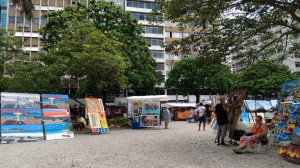
Rio de Janeiro can be a little overwhelming to the first time visitor, especially if you’re on your own and don’t speak Portuguese. Even though Rio is a large international city, don’t expect many people to know English. (If you speak some Spanish, you may have better luck.)
Summer can also be very hot and humid, and if you’re not used to this, it will exhaust you even faster.
After spending a week in the city, I’ve compiled a few tips to help make your first time in Rio more manageable.
Staying safe in Rio
Rio has a lot of very poor people, as well as rich people, living in close proximity. Not surprisingly, this leads to crime. Don’t display wealth (expensive jewelry, cameras, and phones) and avoid walking around late at night.
Ipanema is a safe place to stay and a nice neighbourhood full of shops and restaurants, and of course right next to the famous Ipanema beach. I recommend staying at this AirBnB, especially if you’re solo and it’s your first time in Rio. Denise is a very kind host who speaks good English and will take good care of you! She told me that even in Ipanema it is better to take a cab (or Uber – more on this below) after 10 PM rather than walk.

Even though Ipanema is one of the nicer neighbourhoods, don’t be surprised to see scruffy homeless people sleeping in the middle of the sidewalks.
If you go in summer (December to March), make sure to rent a place with AC; you’ll need it when the temperature (with the humidity factor) feels like 40C.
As well, never walk on the empty beaches at night (or early in the morning), or leave your stuff unattended at the beach during the day.
After first arriving in Rio, I expected thieves and pick-pockets to be everywhere, just waiting to relieve me of my stuff. However, I had two very interesting experiences that show that there are of course honest people in Rio.
On my first morning in the city, I forgot my beloved Tilley hat in a café, and only realized it three hours later. I went back, and lo and behold, was reunited with my hat!
A few days later, I lost my water thermos in a restaurant (it must have fallen out of the side pocket of my knapsack) and with the help of my host, was able to get it back.
Transportation
Rio is a very large city, but visitors tend to focus on the same areas, and those are well served by public transit. Taxis and Ubers are also plentiful.
If it’s your first time in Rio, you should focus on the metro, VLT, and Uber. The buses (with the exception of the “integration buses”) and taxis are more challenging if you don’t speak Portuguese.
Metro and VLT
People familiar with metros (subways) in other cities may find the Rio configuration a little awkward. There are three lines (Linea 1, 2, and …4), with 4 being an extension of 1. Line 2 (not often used by tourists) overlaps line 1 on part of its length.
Think of lines 1 and 4 as one long track, with station Uruguai at one end, and station Jardin Oceanico at the other. So you’re either going in direction Uruguai or Jardin Oceanico.
Stops Antero de Quental and Jardim de Alah serve Leblon Beach. Nostra Senhora da Paz and General Osorio serve Ipanema Beach. Siqueira Campos and Cardeal Arcoverde serve Copacobana Beach. For SugarLoaf (Pan do Azucar), get off at Botafogo and take an “extension bus” (see below). Cinelandia and Carioca serve the centro (downtown).
The VLT is a light rail surface train that connect with the metro and lets you access the Santos Dumont city airport, Museu do Amanhã, Aquarium, and bus station (Rodoviária).

You can buy a RioCard (that covers both the metro and VLT) in the machines at any station and put whatever credit amount you want on them. One passage on the metro is R$4.60 and R$3.80 for the VLT. (The Real – R$ – is the Brazilian currency. 1 CAD is about R$3 and 1 USD is about R$4.)
You can recharge your card at any time at those same machines, but you won’t get change. I believe there is a different card that covers the metro only.
You wave your card in front of the reader at the turnstiles when entering the metro station, and inside the VLT trains. The metro has different turnstiles for the different cards, so if you get an error, you’re likely using the wrong turnstile (or your card has insufficient funds).
Buses
There are three different kinds of buses, operated by different companies. The one you’re most likely to use is the “integration bus” which is in effect an extension of the metro line to access sites such as SugarLoaf or the Christ Redeemer statue. They leave from just outside the metro (for example Botafogo station for SugarLoaf) and are supposed to be included in your metro fare. You need to wave your metro card in front of the reader on the bus to enter, and although it is not supposed to deduct a new fare, you need to have enough funds on the card for one passage!
Taxis
I did not use any taxis while in Rio but they are plentiful and are supposed to use their taximeters. However, they have the reputation of taking tourists around the long way, or making unnecessary detours in order to charge more.
Uber
Uber is very popular in Rio and seemingly used by everybody. I’ll confess that I had never used Uber before, but once in Rio, it was almost unavoidable! Unlike in my hometown of Toronto, cash is a valid mode of payment for Uber in Brazil. You’ll still need to add a credit card, debit card, or Paypal as an additional mode of payment unless you have a CFP (Brazilian taxpayer identification number).
Uber is incredibly cheap in Rio. I paid around CA$11 for 18 kilometres. It’s much cheaper than a taxi and you know you won’t get ripped off. If you’re not set up with Uber, people will even offer to call you an Uber (which you then pay in cash according to a pre-determined amount).
Santos Dumont airport, SugarLoaf (and probably other spots) even have an Uber Lounge which provides free WiFi to set up your ride, and an easy to access pick-up area. Even for a newbie like me who doesn’t speak the language, it was a breeze. (You might want to have Google Translate on your phone though, to exchange messages with your driver.)
Getting to Christ Redeemer (Cristo Redentor)

This is probably the trickiest attraction to reach. Here is a post that describes the many options to get to Cristo Redentor. I ended up taking a van from Praça Lido.
No matter how you get there, be prepared for oppressive crowds, and don’t bother going if it’s overcast or rainy and you can’t see the statue from ground level.
Eating out in Rio
As a first-time visitor to Rio, it took me a lot of trial and error to find good cheap food in the city. I am still not exactly sure what Brazilian food consists of, to be honest.
There are the “per kilo” restaurants, which offer a buffet but charge according to the weight of your food, rather than “all-you-can-eat” for a fixed price. They seem quite popular, and a good option if you’re not too sure what and how much you feel like eating.
You will see a lot of familiar foods advertised on menus, like crepes, pastas, and chilli, but these may not always be what you expect, or even very authentic. Not surprisingly, the best tasting foods seem to be Brazilian specialties, which focus on either meat or fish, such as feijoada or moqueca. Pizzas are also a good bet. I saw many places advertising burgers but didn’t try them.
In my neighbourhood of Ipanema, I quite enjoyed Gringo Cafe (great brunch items) and Torre do Barão (pizza, meat, drinks, etc).

Be aware that most restaurants and cafés add a 10% “service charge” which is essentially a tip. So unless your waiter really went above and beyond, you don’t need to leave extra money.
Enjoying the beaches of Rio
Rio de Janeiro has a truly unique setting, a combination of rocky outcrops draped in greenery laced with a string of golden beaches. Copacabana and Ipanema have been immortalized in popular culture, and project a languid and sensual image.
On summer weekends however, the reality will probably shock you if this is your first time in Rio. Popular beaches like Ipanema, Leblon, and Copacabana are absolutely packed. They looks like beach umbrella cities.

Things get better on weekdays, but don’t expect a tranquil walk along the shoreline while humming the “Girl from Ipanema” to yourself. Your path will be interrupted every 10 metres by groups of young guys playing ball games by the water line. I had to chuckle when I looked into the distance and saw about 20 balls bouncing up and down as far as the eye could see!
There are many smaller beaches in Rio which are not very well known. Tiny Vermelha beach near SugarLoaf is peaceful even in summer, and you may want to take a dip, and a walk along the Cláudio Coutinho trail before visiting the famous attraction.

Practicalities
Money
Lonely Planet warns against Bradesco ATMs, saying that card slots that have been tampered with to steal your card’s number and PIN have seen an increase in recent years. Locals deny this. Who really knows…
Other banks are Banco do Brazil, Santander and Itaú. Banco do Brazil asked for a 6-digit PIN when I used my Maestro debit card. Huh? My AirBnb host suggested I try her bank, Itaú, and that worked on the first attempt. You may need to try a few banks until one accepts your card. Bring cards on both the Maestro and Visa networks to cover all your bases.
Electricity
The electrical outlets I saw in Rio take three round pins in a triangular configuration, but also work with the two round pins of European plugs. Apparently, the North American outlets with two flat pins are also in usage. Make sure you have the adapters to use both. Power is 110 volts but some outlets are 220 volts! Fortunately, most electronics work on dual voltage these days. If yours don’t, bring a converter as well.
I hope these tips gave you a better idea of what to expect from Rio de Janeiro. Be careful but don’t be paranoid. Absolutely nothing bad happened to me over my one-week solo stay. 🙂

Visting a place for the first time is always exciting, thanks for sharing your story…
LikeLike